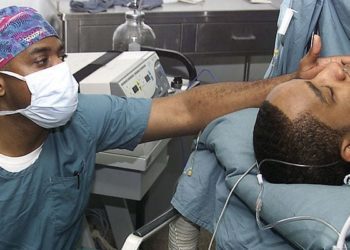2 Minute Medicine Rewind November 26, 2018
The management of acute, radiotherapy-related nociceptive and neuropathic pain in patients undergoing radiotherapy for head and neck cancers remains an ongoing challenge. Pregabalin, an anticonvulsant drug, has been shown to be efficacious in treating various chronic neuropathic pain conditions. In this randomized controlled trial, investigators randomized 128 patients treated with radiotherapy for head and neck cancer to receive either pregabalin or placebo in order to examine the effect of pregabalin on weekly mean pain intensity. During the study, 35.9% of participants received a maximum daily pregabalin dose of 300 mg, 34.4% received a maximum dose of 450 mg, and 29.7% received a maximum dose of 600 mg. Investigators found that after 16 weeks, 29.7% of patients in the pregabalin group achieved pain relief of 50% or greater, as measured using the 11-point numeric rating scale (NRS), compared to 7.8% for placebo (absolute rate difference 21.88%, 95% CI 7.33% to 36.42%, p=0.003). In the pregabalin group, 59.4% of responders also experienced a pain intensity reduction of 30% or greater at week 16 compared to 32.8% of those in the placebo group (absolute rate difference 26.56%, 95% CI 8.35% to 44.77%, p=0.006). In terms of safety and tolerability, 54.7% of patients in the pregabalin and 45.3% of patients in the placebo group experienced at least one adverse event (p=0.29); adverse events included dizziness and somnolence, which were more common in the pregabalin group (6.3% versus 4.7%), though not statistically significant. The results from this study therefore indicate that pregabalin can be used to reduce pain intensity in patients undergoing radiotherapy for head and neck cancers. This study was limited in that more than half of patients included in this study had nasopharyngeal carcinoma, making generalizability of results difficult without larger, more diverse sample size studies.
Deep learning approaches have been proposed as a way to facilitate the interpretation of chest radiographs in low resource settings. In this study, investigators developed a convolutional neural network called CheXNeXt and compared its performance on detecting the presence of 14 different pathologies to the performance of 9 radiologists. CheXNeXt was trained and internally validated on a validation set consisting of 420 images of 14 different pathologies such as pneumonia, pleural effusion, pulmonary masses, and nodules. Radiologists included for comparison included 6 board-certified radiologists (average experience 12 years, range 4 to 28 years) and 3 seniors radiology residents from 3 academic institutions. Investigators found that the algorithm had a mean proportion correct for all pathologies of 0.828 (SD 0.12) compared with 0.675 (SD 0.15) for board-certified radiologists and 0.654 (SD 0.16) for residents. The algorithm had an area under the curve (AUC) of 0.862 (95% CI 0.825 to 0.895) for atelectasis, which was significantly higher than the radiologists’ AUC of 0.808 (95% CI 0.777 to 0.838). Radiologists had statistically significantly higher AUCs for cardiomegaly (AUC 0.888, 95% CI 0.863 to 0.910), emphysema (AUC 0.911, 95% CI 0.866 to 0.947), and hiatal hernia (AUC 0.985, 95% CI 0.974 to 0.991) in comparison to the algorithm (AUC of 0.831 for cardiomegaly, 95% CI 0.790 to 8.70; AUC of 0.704 for emphysema, 95% CI 0.567 to 0.833; AUC of 0.851 for hiatal hernia, 95% CI 0.785 to 0.909). There were no statistically significant differences in AUCs between radiologists and CheXNeXt for the other 10 pathologies. The average time to interpret the 420 images in the validation set was 240 minutes for the radiologists in comparison to 1.5 minutes for CheXNeXt. Taken together, the results from this study indicate that deep learning approaches may be useful for identifying pathologies in chest radiographs in places where radiologists are not readily available
Association of Prenatal Exposure to Air Pollution With Autism Spectrum Disorder
Autism spectrum disorder (ASD) has a poorly understood etiology, with some evidence suggesting that environmental contaminants and air pollution may be potential risk factors. In this cohort study, investigators examined data from 132,256 births in Metro Vancouver, British Columbia, Canada, in order to assess whether maternal monthly mean exposures to particulate matter with a diameter less than 2.5 micrometers (PM2.5), nitric oxide (NO), or nitrogen dioxide (NO2) were associated with their children developing ASD. Environmental exposures at maternal residence during pregnancy were estimated with temporally adjusted, high-resolution land use regression models. Investigators found that out of 132,256 births, 1307 (1.0%) children were diagnosed with ASD by the age of 5 years. For mothers, the median monthly mean exposure during pregnancy of PM2.5 was 3.5 µg/m3 (IQR 2.7 to 4.2), 18.3 parts per billion (ppb) of NO (IQR 14.0 to 24.7), and 14.3 ppb for NO2 (IQR 12.2 to 17.0). After adjusted logistic regression, it was found that mothers exposed to increased amounts of NO had significantly higher odds of having children with ASD (OR 1.07, 95% CI 1.01 to 1.31). The associations for small particulates and NO2 were not statistically significant. In full pregnancy models, the odds ratios for male children were 1.05 for PM2.5 (95% CI 0.98 to 1.10), 1.09 for NO (95% CI 1.02 to 1.15), and 1.07 for NO2 (95% CI 1.00 to 1.13). For female children, the odds ratios were 1.03 for PM2.5 (95% CI 0.90 to 1.18), 0.98 for NO (95% CI 0.83 to 1.13), and 1.00 for NO2 (95% CI 0.86 to 1.16). For male versus female children comparisons in full pregnancy models, tests of interactions between sex and exposure for all air pollutants and time periods were not statistically significant. Overall, results from this study indicate that maternal exposure to NO may be associated with the development of ASD in offspring. This study was limited in that there was limited ability to differentiate between trimester exposures, and therefore, there were no clear trends in increased odds by trimester.
Multicenter Trial of a Combination Probiotic for Children with Gastroenteritis
The use of probiotics has been suggested as a way to improve outcomes in children with gastroenteritis. In this randomized controlled trial, investigators randomized 886 children age 3 to 48 months of age with gastroenteritis to receive a placebo or combination product containing Lactobacillus rhamnosus R0011 and L. helveticus R0062 in order to evaluate the effectiveness of probiotics in preventing moderate-to-severe gastroenteritis. The percentage of participants with a modified Vesikari score of 9 or higher after enrollment (an indicator of moderate-to-severe gastroenteritis) were similar between the two groups (26.1% in probiotic group vs. 24.7%, p=0.65). Researchers found that probiotic use did not prevent the development of moderate-severe gastroenteritis (OR 1.06, 95% CI 0.76 to 1.49, p=0.74). There were also no significant differences observed with respect to median duration of diarrhea (p=0.31) or vomiting (p=0.18). In terms of number of episodes of diarrhea and vomiting, investigators did not observe a significant difference in number of diarrhea episodes (p=0.78), but did observe a higher number of vomiting episodes in the probiotic group (incidence rate ratio 1.36, 95% CI 1.13 to 1.63, p<0.001). Taken together, results from this study indicate that probiotics do not improve outcomes for gastroenteritis, but may, in fact, cause more episodes of vomiting. It should be noted, however, that the trial used a specific probiotic product, making results difficult to generalize to other probiotic products and conditions.
Risk of Suicide After Cancer Diagnosis in England
The receipt of a cancer diagnosis can be devastating, with important implications for a patient’s mental health and well-being. Some evidence has suggested that cancer diagnosis may contribute to an increased risk of suicide in this patient population; however, variation in risk by various patient characteristics has not been well-studied. In this cohort study, investigators utilized data from 4,722,099 adult patients with a cancer diagnosis in order to study the effect of cancer diagnosis on the risk of suicide compared to the general population. Researchers found that out of the 4,722,099 patients identified with a cancer diagnosis, 2491 patients with cancer were identified as having suicide as a cause of death (0.08% of all deaths). The highest standard mortality ratios (SMR) and absolute excess risks (AERs) were observed in patients with mesothelioma, as they had a 4.51-fold risk of suicide compared with the general population (SMR 95% CI 2.91 to 7.00) corresponding to 4.20 extra deaths per 10,000 person-years (AER 95% CI 1.84 to 6.57). Pancreatic cancer (SMR 3.89, 95% CI 2.77 to 5.48), esophageal cancer (SMR 2.65, 95% CI 2.04 to 3.43), lung cancer (SMR 2.57, 95% CI 2.23 to 2.97), and stomach cancer (SMR 2.20, 95% CI 1.71 to 2.84) were also associated with an increased risk of suicide. In contrast, patients with melanoma (SMR 0.80, 95% CI of 0.66 to 0.98) and prostate cancer (SMR 0.90, 95% CI 0.82 to 0.99) had a significantly reduced risk of death by suicide compared to the general population. In terms of timing, SMRs for all cancers were highest in the first 6 months after cancer diagnosis (SMR 2.74, 95% CI 2.52 to 2.98; AER 1.77, 95% CI 1.54 to 2.01) but also remained high over the following 3 years before decreasing in risk over time (p<0.001). In terms of cancer stage, those with stage IV disease had the highest SMR and AER (SMR 2.79, 95% CI 2.24 to 3.47; AER 1.97, 95% CI 1.30 to 2.65), although there was significant heterogeneity found for the association between stage at diagnosis and risk of suicide (p<0.001). Overall, results of this study indicate that cancer diagnosis is associated with an increased risk of suicide, particularly in those with late stage cancer or with certain types of cancer. This has important implications for patients with these risk factors, for whom targeted interventions could potentially prevent deaths due to suicide. This study was limited in that it did not account for ethnicity, preexisting psychiatric disorders, or other confounders such as alcohol or drug use.
Image: PD
©2018 2 Minute Medicine, Inc. All rights reserved. No works may be reproduced without expressed written consent from 2 Minute Medicine, Inc. Inquire about licensing here. No article should be construed as medical advice and is not intended as such by the authors or by 2 Minute Medicine, Inc.









